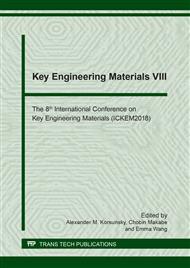[1]
D. Brehl and T. Dow, Review of vibration-assisted machining,, Precision Engineering, vol. 32, pp.153-172, (2008).
DOI: 10.1016/j.precisioneng.2007.08.003
Google Scholar
[2]
M. A. Cerniway, Elliptical diamond milling: kinematics, force and tool wear,, M.Sc. Thesis, North Carolina State University, USA, (2002).
Google Scholar
[3]
W. X. Xu and L. C. Zhang, Ultrasonic vibration-assisted machining: principle, design and application,, Advances in Manufacturing, vol. 3, pp.173-192, (2015).
DOI: 10.1007/s40436-015-0115-4
Google Scholar
[4]
Y.-b. Kim and Y. Roh, New design of matching layers for high power and wide band ultrasonic transducers,, Sensors and Actuators A: Physical, vol. 71, pp.116-122, (1998).
DOI: 10.1016/s0924-4247(98)00151-4
Google Scholar
[5]
J. Kim and I. Choi, Micro surface phenomenon of ductile cutting in the ultrasonic vibration cutting of optical plastics,, Journal of Materials Processing Technology, vol. 68, pp.89-98, (1997).
DOI: 10.1016/s0924-0136(96)02546-0
Google Scholar
[6]
M. A. Cerniway, Elliptical diamond milling: kinematics, force and tool wear,, MS Thesis, North Carolina State University, USA, (2001).
Google Scholar
[7]
C. Ma, E. Shamoto, T. Moriwaki, and L. Wang, Study of machining accuracy in ultrasonic elliptical vibration cutting,, International Journal of Machine Tools and Manufacture, vol. 44, pp.1305-1310, (2004).
DOI: 10.1016/j.ijmachtools.2004.04.014
Google Scholar
[8]
X. Li and D. Zhang, Ultrasonic elliptical vibration transducer driven by single actuator and its application in precision cutting,, Journal of Materials Processing Technology, vol. 180, (2006).
DOI: 10.1016/j.jmatprotec.2006.05.007
Google Scholar
[9]
R. Muhammad, N. Ahmed, A. Roy, and V. V. Silberschmidt, Numerical modelling of vibration-assisted turning of Ti-15333,, Procedia CIRP, vol. 1, pp.347-352, (2012).
DOI: 10.1016/j.procir.2012.04.062
Google Scholar
[10]
X. Zhou, C. Zuo, Q. Liu, and J. Lin, Surface generation of freeform surfaces in diamond turning by applying double-frequency elliptical vibration cutting,, International Journal of Machine Tools and Manufacture, vol. 104, pp.45-57, (2016).
DOI: 10.1016/j.ijmachtools.2015.11.012
Google Scholar
[11]
Z. Haidong, Z. Ping, M. Wenbin, and Z. Zhongming, A Study on ultrasonic elliptical vibration cutting of inconel 718,, Shock and Vibration, vol. 2016, (2016).
DOI: 10.1155/2016/3638574
Google Scholar
[12]
G. L. Chern and Y. C. Chang, Using two-dimensional vibration cutting for micro-milling,, International Journal of Machine Tools and Manufacture, vol. 46, pp.659-666, (2006).
DOI: 10.1016/j.ijmachtools.2005.07.006
Google Scholar
[13]
X. H. Shen, J. H. Zhang, H. Li, J.-J. Wang, and X.-C. Wang, Ultrasonic vibration-assisted milling of aluminum alloy,, The International Journal of Advanced Manufacturing Technology, vol. 63, pp.41-49, (2012).
DOI: 10.1007/s00170-011-3882-5
Google Scholar
[14]
M. M. Abootorabi Zarchi, M. R. Razfar, and A. Abdullah, Investigation of the effect of cutting speed and vibration amplitude on cutting forces in ultrasonic-assisted milling,, Proceedings of the Institution of Mechanical Engineers, Part B: Journal of Engineering Manufacture, vol. 226, pp.1185-1191, (2012).
DOI: 10.1177/0954405412439666
Google Scholar
[15]
M. A. Zarchi, M. Razfar, and A. Abdullah, Influence of ultrasonic vibrations on side milling of AISI 420 stainless steel,, The International Journal of Advanced Manufacturing Technology, vol. 66, pp.83-89, (2013).
DOI: 10.1007/s00170-012-4307-9
Google Scholar
[16]
J. Janghorbanian, M. R. Razfar, and M. M. Abootorabi Zarchi, Effect of cutting speed on tool life in ultrasonic-assisted milling process,, Proceedings of the Institution of Mechanical Engineers, Part B: Journal of Engineering Manufacture, vol. 227, pp.1157-1164, (2013).
DOI: 10.1177/0954405413483722
Google Scholar
[17]
H. Ding, S. Chen, and K. Cheng, Two-dimensional vibration-assisted micro end milling: cutting force modelling and machining process dynamics,, Proceedings of the Institution of Mechanical Engineers, Part B: Journal of Engineering Manufacture, vol. 224, pp.1775-1783, (2010).
DOI: 10.1243/09544054jem1984
Google Scholar
[18]
S. Elhami, M. Razfar, and M. Farahnakian, Analytical, numerical and experimental study of cutting force during thermally enhanced ultrasonic assisted milling of hardened AISI 4140,, International Journal of Mechanical Sciences, vol. 103, pp.158-171, (2015).
DOI: 10.1016/j.ijmecsci.2015.09.007
Google Scholar
[19]
B. Azarhoushang and J. Akbari, Ultrasonic-assisted drilling of Inconel 738-LC,, International Journal of Machine Tools and Manufacture, vol. 47, pp.1027-1033, (2007).
DOI: 10.1016/j.ijmachtools.2006.10.007
Google Scholar
[20]
Y. Wang, H. Gong, F. Fang, and H. Ni, Kinematic view of the cutting mechanism of rotary ultrasonic machining by using spiral cutting tools,, The International Journal of Advanced Manufacturing Technology, vol. 83, pp.461-474, (2016).
DOI: 10.1007/s00170-015-7549-5
Google Scholar
[21]
H. Al-Budairi, Design and analysis of ultrasonic horns operating in longitudinal and torsional vibration,, PhD Thesis, University of Glasgow, UK, (2012).
Google Scholar
[22]
S. Amini, M. Soleimani, H. Paktinat, and M. Lotfi, Effect of longitudinal− torsional vibration in ultrasonic-assisted drilling,, Materials and Manufacturing Processes, vol. 32, pp.616-622, (2017).
DOI: 10.1080/10426914.2016.1198027
Google Scholar
[23]
M. Lotfi and S. Amini, Experimental and numerical study of ultrasonically-assisted drilling,, Ultrasonics, vol. 75, pp.185-193, (2017).
DOI: 10.1016/j.ultras.2016.11.009
Google Scholar
[24]
Z. Zhong and H. Yang, Development of a vibration device for grinding with microvibration,, Materials and Manufacturing Processes, vol. 19, pp.1121-1132, (2004).
DOI: 10.1081/amp-200035263
Google Scholar
[25]
T. Tawakoli and B. Azarhoushang, Influence of ultrasonic vibrations on dry grinding of soft steel,, International Journal of Machine Tools and Manufacture, vol. 48, pp.1585-1591, (2008).
DOI: 10.1016/j.ijmachtools.2008.05.010
Google Scholar
[26]
B. Azarhoushang and T. Tawakoli, Development of a novel ultrasonic unit for grinding of ceramic matrix composites,, The International Journal of Advanced Manufacturing Technology, vol. 57, pp.945-955, (2011).
DOI: 10.1007/s00170-011-3347-x
Google Scholar
[27]
Z. Liang, Y. Wu, X. Wang, and W. Zhao, A new two-dimensional ultrasonic assisted grinding (2D-UAG) method and its fundamental performance in monocrystal silicon machining,, International Journal of Machine Tools and Manufacture, vol. 50, pp.728-736, (2010).
DOI: 10.1016/j.ijmachtools.2010.04.005
Google Scholar
[28]
V. I. Tsiakoumis, An investigation into vibration assisted machining: application to surface grinding processes,, Ph.D. Thesis, Liverpool John Moores University, (2011).
Google Scholar
[29]
M. Paknejad, A. Abdullah, and B. Azarhoushang, Effects of high power ultrasonic vibration on temperature distribution of workpiece in dry creep feed up grinding,, Ultrasonics Sonochemistry, vol. 39, pp.392-402, (2017).
DOI: 10.1016/j.ultsonch.2017.04.029
Google Scholar
[30]
M. Kumar and X. Jin, Effects of vibration assistance on surface residual stress in grinding of Ti6Al4V alloy,, Procedia Manufacturing, vol. 10, pp.171-182, (2017).
DOI: 10.1016/j.promfg.2017.07.045
Google Scholar


